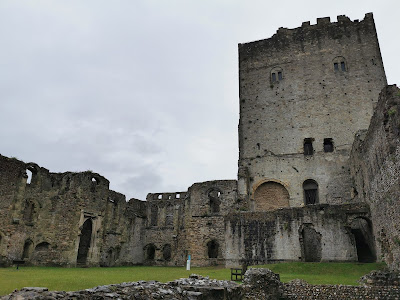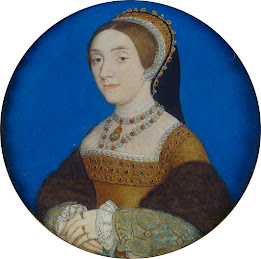I'm taking over the history blog on tour this week, me and Jordan have a week off from work and seeing as it his birthday, I booked some day trips that he has no idea about till we get there. On the first day I took him to Porchester Castle, I grew up going here every school holiday but sadly Jordan has never been.
Our Visit
When we arrived it was still pouring with rain and there was a slight wind in the air, not helped by the fact that Porchester is right on the coast but is in the middle of the harbour. Obviously beacuse of the pandemic a few things have changed. Before we went in I had to change in the car as what I had decided to wear wasn't what I would call appropriate from going round a castle. We walked over the bridge and in to the castle shop, they scanned our tickets and explained how the castle is now laid out. A lovely lady came out and showed us where we had to go and what we had to do seeing as the castle was now a one way system and that there was a school due in soon.

We walked over to the keep and climbed the stairs inside, we had to wear face masks when were inside but when out side we didn't need to. We walked around the floors, reading the placques, looking out the windows and taking photos. The exhibit that they have on the upper floors about the prisoners of Porchester was very interesting to read, I knew a bit about the prisoners that were there but this gave me more insite. We wondered all the way round and then made our way back down to the bottom in to the archaeology museum. This was fascinating to see what had been found on the site and from what time period. Jordan spotted a glass bottle that had been hidden under a floor board and was basically a time capsual.
Once finished in the museum, we walked back outside and had a wonder around the grounds and the ruins. Spotting out along the way where there would have been upper floors, fire places and stair cases. Once done we went back in to the shop were the lovely lady that showed us around at the start was stocking up the shelves. She asked if we had a good time, we both said yes and that we had a few pictures to use in our blog. She asked us about it and she was over the moon when I said that we would be doing a piece on Porchester. Jordan then picked another birthday present, which I shall be subjected to in a few days. May have even treated myself to another book to add to my collection. I suggested that we have a walk round the walls, but seeing as it had started to rain again we decided to head back to the car and head home out the rain.

Ever since I was a kid I have lived going to Porchester Castle. I have run all over that place and remember having picnics with my grandparents on the front lawn. I never get board going to visit as find there is enough history to walk through and discover. As I said before we will definitely have to go back when it's not raining. When we were leaving Jordan found something that I can't say I have ever before. On the wall there was names carved into the walls that dated back to the 1800s. It's stuff like that I love as it add more history to a place that is already century's old. I will continue to go to Porchester as what is there is so fascinating and seeing as it's the earliest historical place I remember going to as a kid, I hope to carry that on when I have my own.
The History
Porchester Castle was a Roman Fort that was part of a series of coastal forts that were known as the Forts of the Saxon Shore. They were built in the 3rd century to fight the Saxon Pirates that were raiding the south coast. Porchester was even recorded in the Roman document 'Notitia Dignitatum', this was a list of military command and civil service posts that were across the whole empire. There is no known date as to when the fort was actually built, but coins found on the site date to AD 285, it was possibly built under the command of Marcus Aurelius Carausis who had been appointed to command the Roman fleet in the Channel.
Carausus had a falling out with the Roman Empire and was put to death but the new Emperor Maximian. But Carausus rebelled and named himself emperor of England and Northern Gaul. An emissary we sent and he was assassinated. The fort was in constant use up to the end of the Romans in Britain. The fort contained timber houses, workshops, animal pens, cesspits and rubbish heaps. This also applies that there were civilians here along with the military.

After the Romans left and before the Norman conquest, it evident that a community of people lived within the fort. Four huts, a well and signs of farming were found dating to the 5th century. Between the 7th and 9th century more timber houses and ancillary buildings were built. In 904 the fort was given to King Edward the Elder by the Bishop of Winchester. It then became a burh and was part of a series of fortified places that would protect England against thr Vikings. During the 10th century a large hall, courtyard and stone tower were built, which suggests that someone important lived here. A cemetery was found that contained 21 graves.
When the Domesday Survey was carried out in 1086, Porchester was made up of 3 manors before the Norman Conquest. The manor was given to William the Conquer by one of his supporters William Mauduit. By the time that he had died he had either laid out the inner bailey or the courtyard. It then passed into the hands of his son Robert, but he died in a shipwreck meaning the castle fell into the hands of the Crown. It's unclear as to what took place during this time, the keep had started to been built and was dramatically finished. An Augustinian priory was then founded in 1128. A few years later they moved to Southwick and the buildings they lived in were destroyed, but the Church still stand. Much of the ground was divided into plots for use in farming, while outside the walls the village of Porchester started to grow.
Henry of Anjou, handed the castle to Henry Maudit, a descendant of William Mauduit. However, when Henry of Anjou became King he took the castle back and would remain in the hands of the Crown until 1632. He found Porchester to be very useful and would stay there before he went over to visit his territories in France. He also used it as a prison and kept important prisoners there. On the odd occasion the castle was garrisoned and furnished with supplies. More stone buildings were built along within the inner bailey, the west side, a hall over the basement and on the south-east side next to the gatehouse. Many of these buildings remained unchanged, while over the water Portsmouth was being developed. King John visited regularly and had a new chamber and wardrobe built.
Edward II had the castle garrisoned fearing an invasion from France, in total between 1320 and 1326 over £1,100 was spent. The old Roman gates were remodelled and the fore buildings of the keep were enclosed with new building. Most Kings used Porchester as a stopping off place before going off to France. So much so Richard III rebuilt the inner bailey and turned it into miniature palace with royal apartments. Henry V stayed at Porchester before he went to France for the battle of Agincourt. While at the castle a plot that was devised to murder him was uncovered. Its possible that he confronted those involved while at Porchester.
Despite Portsmouth's growing economic and military power, Henry V choice it as the landing spot for his new bride Margaret of Anjou. When the Tudors came to the throne, Porchester remained a coastal defence and just before she died Elizabeth I held council there. Not long after that Sir Thomas Cornwallis had the inner bailey remodelled. Under the rule of Charles I the castle was sold to a local landowner, Sir William Uvedale. In 1665, the castle was first used to hold captured enemy soldiers while at war with the Netherlands. The government rented the castle and housed 500 Dutch prisoners. During the 18th century it was used again and housed mostly French captives. Then during the War of Austrian Succession, it housed 2,500 prisoners.
During the French Revolution and the Napoleonic Wars, Porchester played a big part. It was one of 12 main prisoner of war depots in England and housed 8,000 at any one time. There were prisoners of many different nationalities and backgrounds brought to the castle during the wars. In 1796 a group of 2,000 black and mixed race were brought from the Caribbean and held for a year. Some of the French captives had one of the rooms in the keep transformed into a theatre. In 1814 the last of the prisoners left Porchester. Once the prisoners had left, the castle was abandoned and later returned to its owners the Thistlethwayte family. During the 19th century it became a tourist attraction, it had a pleasure garden and a place of entertainment.
In 1926 the family decided to place the site under the guardianship of the Ministry of Work as an ancient monument. The they then cleared vegetation, repaired the walls and excavated the moats. In the 1980's Porchester Castle went into the care of English Heritage. During the 1960's to the 1970's a major archaeological excavation took place. Thousands of items were found that dated from prehistoric to the 19th century. Many hidden buildings were also found.










Comments
Post a Comment